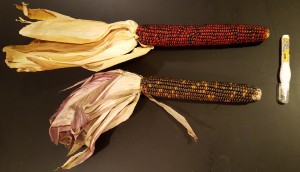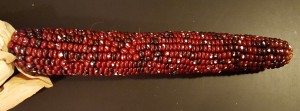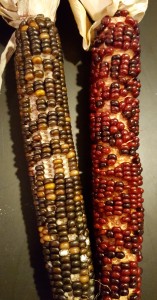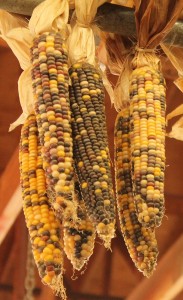Math Monday: Corn Pixel Art
It’s time to start filling our mathematical cornucopia. Probably the most classical item to place in a cornucopia is decorative multicolored corn. But usually that has a very random pattern of coloration. Although randomness can be analyzed mathematically, sometimes to demonstrate mathematical ideas you want more precise control over your maize patterning. And that’s where Corn Pixel Art comes in.
Get started by finding some ears of corn with very dark kernels, as uniform as possible, such as these. Use some removable marking device to identify the kernels that should be part of your pattern. Ordinary white-out works extremely well — it sticks to the kernels, is very visible, and rubs off easily if you make a mistake.
One classic mathematical pattern you can make on a cylinder is a helix (basically a spiral around the surface of the cylinder) so in this first design we’ve marked off a double helix in each direction: two progressing one row to the right and one kernel down in each step, starting on opposite sides of the ear, and the other two progressing one row to the left and one kernel down.
Once you have marked all of the kernels in the pattern, remove them one at a time. They pull out easily using needlenose pliers. You may occasionally knock out a kernel that you did not intend to. Such kernels easily glue back into place with any fast-bonding glue, but make sure to re-glue them right away, before you lose track of which kernel and which spot on the cob need to be reunited.


Here’s the double double helix corn with all of the marked kernels removed, pictured from both sides. The crisscrossing helices create lovely diamond patterns among the remaining kernels.


For the second design, we settled on something relevant to this column, along with a pattern of knight’s moves (or rough approximations to them, given the irregularity of the corn-kernel grid) serving as the background.
It occurs to me that you could use this technique to create a labyrinth among the remaining kernels, creating a whole new kind of maize maze. If you create one, or other worthy objet d’corn art, send pictures to mondays@momath.org.
